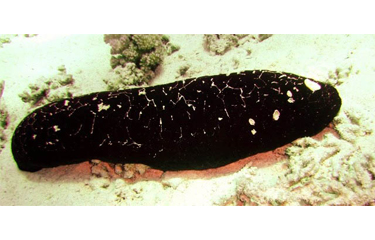Surging imports of sea cucumber into the United States have prompted the Center for Biological Diversity to seek to outlaw the trade in a sub-species, the black teatfish.
The Tucson, Arizona, U.S.A.-based conservation-focused nonprofit has filed a petition with the U.S. Secretary of Commerce’s National Marine Fisheries Service, requesting that it list the black teatfish under the Endangered Species Act because overfishing of the species –not found in U.S. waters – has left it exposed to extinction. The black teatfish’s listing as an endangered species would outlaw its trade or import of into the U.S.
Black teatfish populations have declined by up to 70 percent across 80 percent of their range, according to the petition. Meanwhile, the volume of U.S. sea cucumber imports increased 36 times in volume over the past decade. According to CBD research, the U.S. imported more than 3.6 million kilograms of sea cucumbers (both live and dried) in 2014 from 22 different sea cucumber species, compared to 99,000 kilograms in 2007. Figures for 2019 aren’t cited.
Numerous instances of seizures by U.S. authorities last year suggest the country may be a transhipment hub for smugglers of sea cucumber from other parts of the Americas – including countries that don’t have export protocols for seafood with China, the key export market for the species, according to Sarah Uhlemann, director of the international program director and senior attorney at the CBD.
“I’m not aware of the US exporting or trans-shipping teat fish, though the US does fish for and export other sea cucumbers … We have not yet begun working with fishermen on this issue,” Uhlemann told SeafoodSource.
“There is one study that says that imports are driven by demand within Asian communities for consumption. However, the data we have doesn’t say who the end purchaser is, so we can’t be certain,” she said.
Known for their ability to recycle nutrients and improve water quality, black teatfish live among tropical reefs and seagrass in the Indian Ocean and along the east coast of Africa, as well as along the west coast of India. Also known as bêche-de-mer or trepang, sea cucumber is in high demand in Asia – usually sold dried and then reconstituted – for prices that often reach several hundred U.S. dollars per kilogram.
Anecdotal evidence suggests Mexico, Ecuador, Peru, and parts of Central America are hotspots for poaching of sea cucumber which is shipped to China, Uhlemann said. Alejandro Olivera, CBD’s representative in Mexico, said other species besides the black teatfish are also being threatened by an increased appetite globally for sea cucumber. Particularly vulnerable in Mexico is the overfished chocolate chip sea cucumber (Isostichopus badionotus), which is native to the Yucatan Peninsula.
“The population is overfished because of the lack of enforcement and poaching. This species is not protected by Mexican regulations but it has a yearly ban and a management plan,” Olivera told SeafoodSource. “There have been several clashes, so the fishery is a big social and environmental problem.”
Last year, with backing from the U.S. and European Union, the black teatfish and two other sea cucumber species were listed as restricted under the Convention of International Trade of Endangered Species (CITES). But the harvest and trade of teatfish is still permitted, subject to monitoring and permits.
Photo courtesy of Fernando Herranz-Martin/Wikimedia







